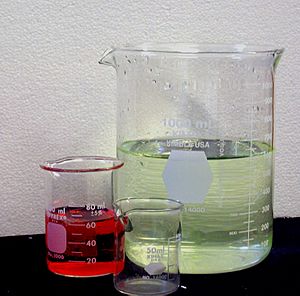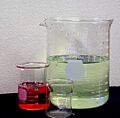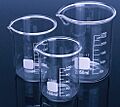Beaker (laboratory equipment) facts for kids

Beakers of several sizes
|
|
| Uses | Liquid volume containment and measurement |
|---|---|
| Related items | Laboratory flask |
A beaker is a common piece of laboratory equipment. It's usually a cylinder-shaped container with a flat bottom. Most beakers have a small pouring spout, which helps you pour liquids easily. You can find beakers in many sizes, from tiny ones (like 1 milliliter) to very large ones (several liters).
Beakers are different from flasks because their sides are straight, not sloped. There is one special type called a Philips beaker, which has slightly slanted sides.
Beakers are often made of borosilicate glass, which is a strong type of glass. But they can also be made from metal like stainless steel or aluminum. Some are even made from certain plastics, such as polythene or polypropylene. For example, polypropylene beakers are often used to check liquid and solid samples using a special analysis method.
Contents
What is a Beaker Used For?
Beakers are super useful in a science lab! They are used for many different things, like:
- Mixing chemicals
- Heating liquids
- Holding liquids during experiments
- Preparing solutions (when you dissolve something in a liquid)
Types of Beakers
There are a few main types of beakers:
- Low-form Beakers (A): These are the most common type. They are also called Griffin beakers, named after John Joseph Griffin who designed them. They are about 1.4 times taller than they are wide. You'll see these used for almost everything in a lab, from making solutions to holding waste liquids.
- Tall-form Beakers (B): These beakers are about twice as tall as they are wide. They are sometimes called Berzelius beakers, after Jöns Jacob Berzelius. They are often used for a process called titration, which is a way to find out how much of a substance is in a liquid.
- Flat Beakers (C): These are often called "crystallizers." They are mostly used to grow crystals from a liquid. They can also be used for heating things in a hot water bath. These beakers usually don't have measurement marks on the side.
Covering a Beaker
Because beakers have a spout, they can't have a tight lid. But if you need to protect what's inside from dust or stop it from evaporating, you can cover a beaker with a watch glass. A watch glass is a round, slightly curved piece of glass that sits on top. It lets air escape through the spout while keeping the contents safe. Sometimes, a larger beaker turned upside down can also be used as a cover.
Measuring with Beakers
Beakers often have lines on their side that show you the volume of liquid inside. For example, a 250 mL beaker might have marks for 50, 100, 150, 200, and 250 mL.
However, these marks are only for a rough idea of the volume. They are not meant for exact measurements! If you need to measure a liquid very precisely, you would use a graduated cylinder or a volumetric flask. Most beakers are only accurate to about 10%.
Images for kids
See also
 In Spanish: Vaso de precipitado para niños
In Spanish: Vaso de precipitado para niños






